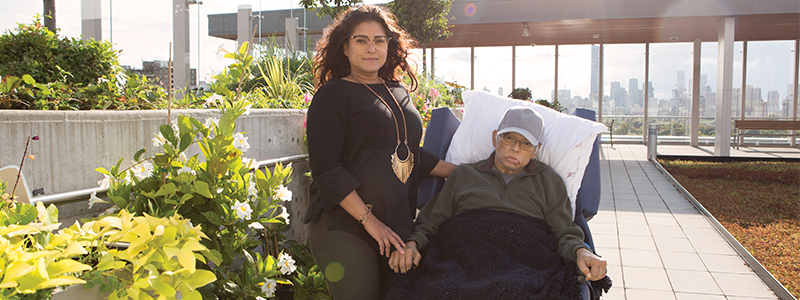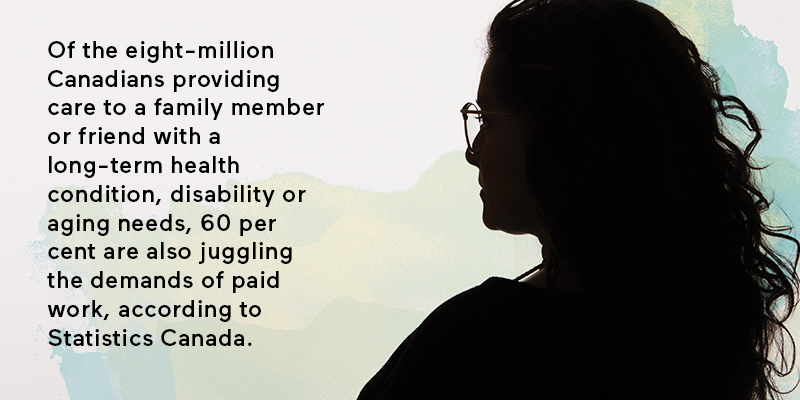
 Above: Caregiver Monika Woodruff and her father Manirul Syed in The Harold E. Ballard Garden on the rooftop of Bridgepoint Active Healthcare
Above: Caregiver Monika Woodruff and her father Manirul Syed in The Harold E. Ballard Garden on the rooftop of Bridgepoint Active Healthcare
Written by: Marcia Kaye
Photos by: John Packman
The last thing Monika Woodruff expected was to become a caregiver at age 37. The Toronto woman was busy planning her wedding, enjoying downtown life and beginning a challenging new career as a regional manager for a luxury eyewear company. But suddenly her father, Manirul Syed, an independent 73-year-old, suffered a debilitating stroke.
After being stabilized in hospital, he was too incapacitated to go back to his apartment, so he was moved into Bridgepoint Active Healthcare, a rehab and complex care hospital, part of Sinai Health System, while waiting for space in a government-funded long-term care facility. That was more than three years ago. He’s still waiting. Monika’s parents had divorced decades earlier, her brother had moved to California, and other relatives lived in her father’s homeland of Bangladesh. So Monika was thrust into the role of caregiver, a job for which she had no training or experience.
“I didn’t know what to do,” Monika recalls. “I figured the health-care system would do what’s supposed to be done, but then all of a sudden his hair was too long. How do we give him a haircut? His toenails were too long, and because he’s diabetic [where a nick can cause a serious infection] I didn’t feel comfortable cutting them. His eyeglasses went missing and none of us had his prescription. We were overwhelmed.”
No sooner had Monika dealt with one issue than another would appear. To complicate things, Manirul’s condition worsened. Today he can no longer walk, eat solid food or easily express his needs. He’ll tell the social worker one thing, his daughter another. He gets frustrated, angry and sometimes aggressive; these behavioural issues now limit his eligibility for certain long-term care placements. Monika still isn’t sure how much of her dad’s personal belongings, such as clothes, pictures and books, she should move into his room. It’s spacious but has limited storage, and she still has no idea how much longer he’ll be there.

It’s a stressful situation for Monika. How stressful? “On a scale of one to 10, I’d say nine-and-three-quarters,” she says. She’d like to spend more time with her dad, but her full-time job prevents that. She and her husband, Mason Woodruff, a welder, need two incomes not only to support themselves but also to pay for extras for Manirul, such as a TV in his room. “I feel guilty that I can’t do more,” she says.
Monika’s situation is not unusual. Of the eight-million Canadians providing care to a family member or friend with a long-term health condition, disability or aging needs, 60 per cent are also juggling the demands of paid work, according to Statistics Canada.
Informal unpaid caregivers like Monika play a critical role, saving Canada’s health-care system at least $26 billion a year, says Dr. Kerry Kuluski, a scientist at Bridgepoint Collaboratory for Research and Innovation, a leading health services research centre that is part of the Lunenfeld-Tanenbaum Research Institute. “But the cost of caregiving is huge,” she says. Caregivers spend their own money on supports for their loved one. Some retro fit their homes with ramps and grab bars. Some give up sleep, social life, vacations, promotions and even fulltime jobs. “Caregivers don’t necessarily want to relinquish their role, but they’re very open in talking about how hard it is,” she says.
Even when patients are in hospital, caregivers do a lot to fill the gaps, says Kerry, who is leading a research study on caregivers and patients experiencing a delayed hospital discharge. For instance, busy staff deliver meal trays, but a patient may have difficulty taking lids off containers, a small but crucial task that may fall to a caregiver. The caregiving role often includes help with getting dressed, doing laundry, going for walks to keep the patient mobile, and dealing with personal grooming such as shaving and hair washing.
The cost of caregiving is huge. Caregivers spend their own money on supports for their loved one. Some retrofit their homes with ramps and grab bars. Some give up sleep, social life, vacations, promotions and even full-time jobs.
- Dr. Kerry Kuluski, Scientist, Bridgepoint Collaboratory for Research and Innovation
But it’s not all work. Caregivers also report very positive experiences. One woman in Kerry’s study enjoyed a new closeness with her mother, who had Alzheimer’s disease: she and her mother would hold hands and reminisce. “She referred to it as ‘stolen moments,’ and she valued that time together,” Kerry says.
Monika can relate to that. She and her husband enjoy taking her father up to Bridgepoint’s rooftop garden, where they sit and have coffee and Manirul shows obvious delight in the displays of plants and flowers. She calls Bridgepoint a beautiful facility, is happy that her father’s room is large and bright with a pleasant view of homes and trees, and praises the staff. “Honestly, some of the nurses are fantastic,” she says. “I didn’t realize my father liked colouring or drawing with a pen. One of the nurses was showing me, and that helped me spend a different kind of quality time with my father.” She’s also grateful to Social Worker Michael Palomo, who acts as liaison with the medical team.

Above: Dr. Kerry Kuluski, Scientist, Bridgepoint Collaboratory for Research and Innovation
One objective is to identify caregivers as soon as a patient is admitted. “We want to find out not only what the patient needs but what the caregiver needs,” Kerry explains, “because we know that once the patient goes back home, the burden of care goes to the caregiver. And if the caregiver isn’t supported, the patient’s coming right back into the hospital, so there’s a huge system benefit from supporting the caregiver.”
With full support from leadership and with caregivers on the steering committee, Kerry is confident change is coming. “We’re very much in the planning stages right now,” she says, “but I think we’re going to see a shift in the culture of care.”
Kerry envisions a culture where caregivers are treated like members of the care team while also maintaining their identity outside of caregiving. For instance, a caregiver who wants to participate in a social activity should be able to do that without guilt, and with respite care providing support to the loved one during that time. “Really simple things like that can make a huge difference.”
*We are sorry to report that Mani passed away in early 2018.